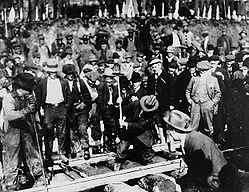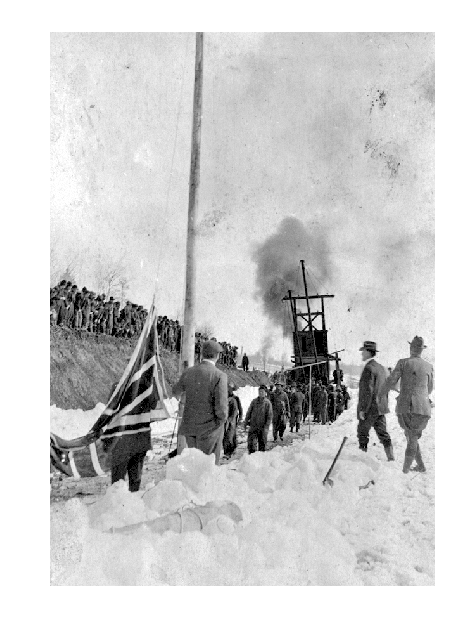.gif)
Last Spike (Grand Trunk Pacific Railway)
Encyclopedia
The Last Spike of the Grand Trunk Pacific Railway was driven one mile east of Fort Fraser, British Columbia
, Canada
on April 7, 1914.

commenced construction in British Columbia in 1908. This was one of the most difficult sections of track ever to be laid in North America
and would cost approximately $112,000 per mile. There were two ends of construction, one being built from Prince Rupert
east and one from Winnipeg, Manitoba west. In British Columbia, the railway had to cope with incredibly difficult terrain, extreme weather conditions and a shortage of workers. For example, the 186 mile section of track from Prince Rupert to Hazelton
took four years to complete (1908-1912), in part because the construction of the 80 mile section from Prince Rupert to the Kitselas Canyon
required 12 million pounds of explosives that were used in the creation of three tunnels that had to be blasted through solid rock.
The costs of building the railway through the Northern Interior of British Columbia were much higher than the company had projected and disputes with rival town-site holders, especially at Hazelton and Fort George
cut even deeper into the company's profits.
Then, in 1912, the Grand Trunk Pacific was dealt another blow when its brilliant general manager Charles Melville Hays
was lost in the sinking of the Titanic. Despite these obstacles and tragedies, the railway was completed and the vision of Charles Hays was finally realized.
The president of the Grand Trunk Pacific, Edson J Chamberlain and AW Smithers, chairman of the board of directors, and other officers of the company all arrived by train from Winnipeg and Montreal
, while from Prince Rupert, more dignitaries came for the ceremony, among these, General Superintendent WCC Mehan, Superintendent GA McNichol, Division Engineer CC Vanarsdol and Assistant Engineer WH Tobey.
 The ceremony began with a race between the track-layers and crews from the eastern and western ends of construction. The last mile had been left unfinished and each crew was timed to see who could complete their last half mile the fastest. The eastern crew won by a margin of only a few minutes and then the western crew placed the last rail.
The ceremony began with a race between the track-layers and crews from the eastern and western ends of construction. The last mile had been left unfinished and each crew was timed to see who could complete their last half mile the fastest. The eastern crew won by a margin of only a few minutes and then the western crew placed the last rail.
Edson Chamberlain drove the last spike
, (not a golden one but a standard black iron one), and once he completed that task, he gave gold watches to the men in charge of each crew. Painted on the last tie was "Point of Completion April 7th, 1914". After the ceremony, that last 11ft. section of rail was removed and sliced into sections and then polished and engraved. The pieces were given to railway officials as paper-weights. One of these is in the possession of the Prince George Railway and Forestry Museum.
Fort Fraser, British Columbia
Fort Fraser is an unincorporated community of about 1000 people, situated near the base of Fraser Mountain, close to both Fraser Lake and the Nechako River. It can be found near the geographical centre of British Columbia, Canada, west of Vanderhoof on the Yellowhead Highway...
, Canada
Canada
Canada is a North American country consisting of ten provinces and three territories. Located in the northern part of the continent, it extends from the Atlantic Ocean in the east to the Pacific Ocean in the west, and northward into the Arctic Ocean...
on April 7, 1914.

History
The Grand Trunk Pacific RailwayGrand Trunk Pacific Railway
The Grand Trunk Pacific Railway was a historical Canadian railway.A wholly owned subsidiary of the Grand Trunk Railway , the GTPR was constructed by GTR using loans provided by the Government of Canada. The company was formed in 1903 with a mandate to build west from Winnipeg, Manitoba to the...
commenced construction in British Columbia in 1908. This was one of the most difficult sections of track ever to be laid in North America
North America
North America is a continent wholly within the Northern Hemisphere and almost wholly within the Western Hemisphere. It is also considered a northern subcontinent of the Americas...
and would cost approximately $112,000 per mile. There were two ends of construction, one being built from Prince Rupert
Prince Rupert, British Columbia
Prince Rupert is a port city in the province of British Columbia, Canada. It is the land, air, and water transportation hub of British Columbia's North Coast, and home to some 12,815 people .-History:...
east and one from Winnipeg, Manitoba west. In British Columbia, the railway had to cope with incredibly difficult terrain, extreme weather conditions and a shortage of workers. For example, the 186 mile section of track from Prince Rupert to Hazelton
Hazelton, British Columbia
Hazelton is a small town located at the junction of the Bulkley and Skeena Rivers in northern British Columbia, Canada. It was founded in 1866 and has a population of 293...
took four years to complete (1908-1912), in part because the construction of the 80 mile section from Prince Rupert to the Kitselas Canyon
Kitselas Canyon
Kitselas Canyon, also Kitsalas Canyon is a stretch of the Skeena River in northwestern British Columbia, Canada, between the community of Usk and the Tsimshian community of Kitselas. It was a major obstacle to steamboat travel on the Skeena River....
required 12 million pounds of explosives that were used in the creation of three tunnels that had to be blasted through solid rock.
The costs of building the railway through the Northern Interior of British Columbia were much higher than the company had projected and disputes with rival town-site holders, especially at Hazelton and Fort George
Prince George, British Columbia
Prince George, with a population of 71,030 , is the largest city in northern British Columbia, Canada, and is known as "BC's Northern Capital"...
cut even deeper into the company's profits.
Then, in 1912, the Grand Trunk Pacific was dealt another blow when its brilliant general manager Charles Melville Hays
Charles Melville Hays
Charles Melville Hays was an American railway executive of the Grand Trunk Railway. He died at sea on the RMS Titanic.-Early years:...
was lost in the sinking of the Titanic. Despite these obstacles and tragedies, the railway was completed and the vision of Charles Hays was finally realized.
Ceremony
On April 7th, 1914, the Grand Trunk Pacific Last Spike ceremony was held 1.5 km east of Fort Fraser BC, approximately 135 km west of what is now Prince George.The president of the Grand Trunk Pacific, Edson J Chamberlain and AW Smithers, chairman of the board of directors, and other officers of the company all arrived by train from Winnipeg and Montreal
Montreal
Montreal is a city in Canada. It is the largest city in the province of Quebec, the second-largest city in Canada and the seventh largest in North America...
, while from Prince Rupert, more dignitaries came for the ceremony, among these, General Superintendent WCC Mehan, Superintendent GA McNichol, Division Engineer CC Vanarsdol and Assistant Engineer WH Tobey.

Edson Chamberlain drove the last spike
Last Spike
The Last Spike is the final rail spike driven in the construction of a railway. It is often a momentous occasion, and special ceremonial spikes of gold or silver may be used.Last Spike may refer to:*Last Spike , driven in 1885...
, (not a golden one but a standard black iron one), and once he completed that task, he gave gold watches to the men in charge of each crew. Painted on the last tie was "Point of Completion April 7th, 1914". After the ceremony, that last 11ft. section of rail was removed and sliced into sections and then polished and engraved. The pieces were given to railway officials as paper-weights. One of these is in the possession of the Prince George Railway and Forestry Museum.

